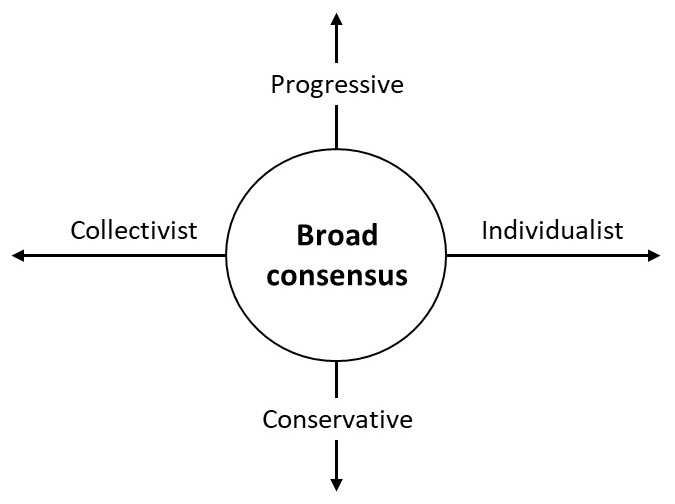6.2.6 Political Parties and Policies
Politicians in a democracy work together to form political parties, whose policies need to adapt to circumstances and public opinion
Previous sections in this chapter have identified different ideologies and implementation approaches to government, categorised as four possible directions away from the status quo (6.2.1). They correspond to different ideas about the policies that enable people to live together peaceably, but there is considerable scope for agreement on many issues.
Politicians need to differentiate themselves to gain power, during an election for example, by describing what policy direction they want to take – as illustrated. They cannot avoid making compromises when they are in power however, to achieve a broad consensus with moderate policies. They risk alienating large numbers of voters if they adopt extreme positions.

Political parties are formed around shared ideas in representative democracies. Politicians increase their influence by working together and pooling resources, to communicate with voters. Big political parties garner more news coverage than small ones, and they can afford better advertising, but a large party containing a ‘broad church’ of opinion is in danger of splitting. For example, AP News reported that “Republicans confront bitter divide; no clear path forward” in January 2023.
The following sub-sections examine how party policy is formed, both at the time of an election and subsequently as circumstances change:
● Parties must make tactical decisions about which groups of voters they need to attract, before setting out overarching policies before each election. These are normally published in the form of a manifesto or party platform. Individual voters can then choose which party they will vote for (6.2.6.1).
● Governments, and opposition parties, must react as situations develop. They must adjust their direction if necessary, as if they were piloting an aeroplane in blustery conditions (6.2.6.2). The population can influence such adaptive policy-making in some political systems: having a hand on the ‘joystick’, as it were, between elections.
● A government knows that some people will have supported a different party at the last election. It ought to try to persuade people with different views to accept the way it handles political issues (6.2.6.3). It can do this by examining each possible policy perspective before taking a decision. It is desirable that it adopts a centrist stance, to maximise its acceptability.
Centrism is re-examined at the end of this book (9.2). The individualist desire for liberty ought to be accommodated, but individualists must also meet their responsibilities to the rest of society.
This page is intended to form part of Edition 4 of the Patterns of Power series of books. An archived copy of this page is held at https://www.patternsofpower.org/edition04/626c.htm